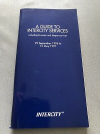hexagon789
Veteran Member
I was comparing 1970 with 1980; according to those two maps:
1970 Glasgow 5hr 54 and in 1980 5hr 08
1970 Edinburgh 5hr 45 and in 1980 4hr 37
Glasgow led from extension of electrification in 1974 reducing journey times to 5 hours-5hrs 07 for most services with Edinburgh being 5h30 at best in the same period.The difference in the timings between various places is interesting to see. Edinburgh has improved a fair bit with Glasgow now lagging behind compared to the 1970 map...
HSTs took it to 4h37 best time London-Edinburgh in one swoop, shaving 53 mins off the time despite only 100mph being permitted north of Edinburgh then.
London-Glasgow has never again been quicker since the HSTs were introduced to the ECML, there was even a period where it was quicker to go to Glasgow via Edinburgh up the ECML than direct up the WCML after the InterCity 225s were introduced.


